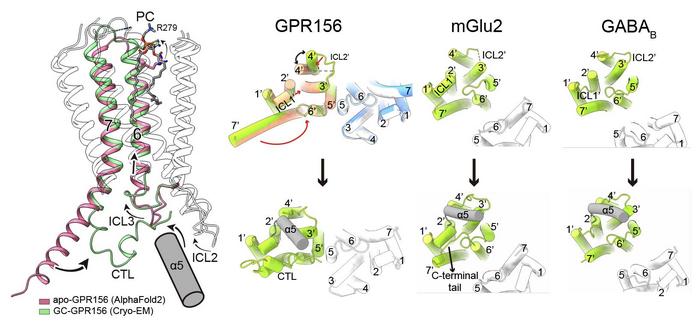Deep inside the inner ear, the cochlea is responsible for detecting sound, while the vestibular apparatus maintains balance. Cells within these structures contain a special receptor protein called GPR156, which belongs to the class C orphan G-protein-coupled receptor (GPCR) family. When activated, GPR156 binds with G-proteins inside the cell, allowing signals to be transmitted. Unlike other GPCRs, GPR156 remains active even without external stimuli, playing a crucial role in maintaining hearing and balance functions. Understanding the structure and function of GPR156 could lead to new treatments for people with congenital hearing impairments.
Cryo-EM Analysis Reveals GPR156’s Unique Structure
A collaborative research team led by Professor Yunje Cho from Pohang University of Science and Technology (POSTECH) used cryo-electron microscopy (cryo-EM) to study GPR156 in unprecedented detail. They analyzed the receptor in two states: Go-free and Go-coupled, revealing the mechanisms behind its ability to maintain high activity without activators.
The team discovered that GPR156 is activated by interacting with abundant lipids in the cell membrane, which causes structural changes when it engages with G-proteins in the cytoplasm. Interestingly, GPR156 has a unique flexibility in changing the structure of its seventh helix as it crosses the cell membrane, allowing it to bind with G-proteins and activate signals to detect sound. This sets GPR156 apart from conventional GPCRs.
Implications for Treating Hearing Impairments
The study’s findings represent a significant step forward in understanding the structural dynamics and activation mechanisms of GPR156. Professor Yunje Cho of POSTECH expressed hope that this research will lead to new treatments and drug discoveries for people with congenital hearing and balance impairments.
“Congenital hearing and balance impairments afflict numerous individuals. I am hopeful that our research will pave the way for groundbreaking treatments and drug discoveries to alleviate their suffering,” Professor Cho stated.
The research team included collaborators from Kyung Hee University (KHU) in South Korea, the University of Southern California (USC) in the United States, and the University of Oxford in the United Kingdom. The study was published online in the journal Nature Structural & Molecular Biology and received financial support from the National Research Foundation of Korea.
This groundbreaking research sheds light on the complex workings of the inner ear and the critical role of GPR156 in maintaining hearing and balance. By unraveling the secrets of this unique receptor protein, scientists are one step closer to developing innovative treatments for individuals with congenital hearing impairments, offering hope for improved quality of life.


